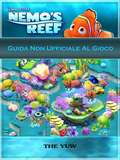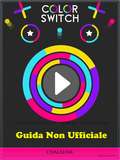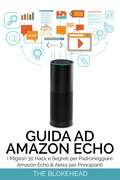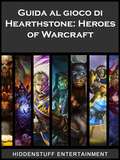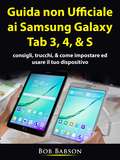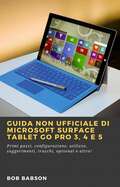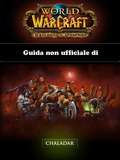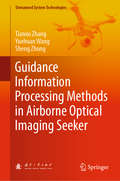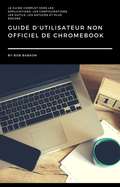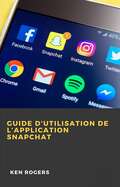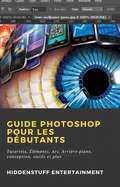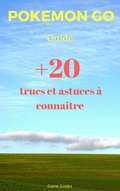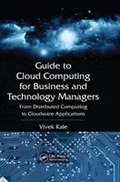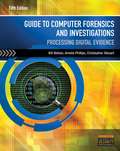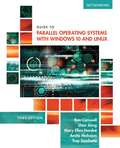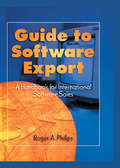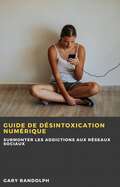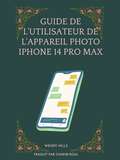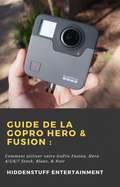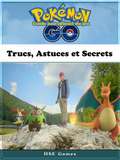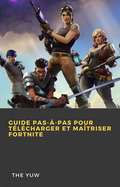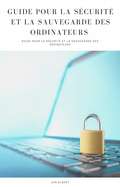- Table View
- List View
Guida Non Ufficiale Al Gioco Nemo's Reef
by The Yuw Wanda SalatinoGuida avanzata di trucchi e consigli. Si tratta dell'unica e più esaustiva guida repreibile online. Disponibile per il download automatico direttamente sul tuo cellulare, sul dispositivo eBook device, o in forma cartacea. Dall'esperienza di centinaia di altre guide e strategie pubblicate, ecco un'altra guida professionale per giocatori novizi o veterani. La guida fornisce strategie e suggerimenti specifici su come andare avanti nel gioco, battere gli avversari, guadagnere crediti e molto altro! - Suggerimenti e strategie professionali - Trucchi e Hack - Segreti, consigli, trucchi, obiettivi sbloccabili utilizzati dai giocatori professionisti! - Come ottenere una montagna di crediti - E MOLTO ALTRO! Tutte le versioni di questa guida sono corredate da screenshot per aiutarti a capire meglio il gioco. Non esiste altra guida così completa ed esaustiva! Disclaimer: Questo prodotto non è associato, affiliato, approvato o sponsorizzato dal/i proprietario/i originale/i del copyright.
Guida Non Ufficiale Color Switch
by The Yuw Martina SimonettiLa Guida Non Ufficiale di Color Switch è un eccellente manuale contenente tutte le informazioni di cui avete bisogno per giocare e non solo! Nel presente libro troverete una guida dettagliata e illustrata per installare il gioco su ogni dispositivo disponibile, dopodiché una sezione apposita vi mostrerà ogni aspetto del gioco e del suo funzionamento, incluse le varie modalità esistenti. Infine, vi saranno offerti una serie di consigli e trucchetti per poter superare i livelli e guadagnare punti più facilmente! Alla fine del libro troverete anche un Bonus lettore, che vi è offerto gratuitamente da HiddenStuff Entertainment. Buona lettura!
Guida ad Amazon Echo: I Migliori 30 Hack e Segreti per Padroneggiare Amazon Echo & Alexa per Principianti
by The BlokeheadLa Perfetta Guida ad Amazon Echo! Questo libro è un compagno comodo e completo che vi permetterà di installare ed usare il vostro Amazon Echo in modo veloce ed efficiente, senza conoscenze di base. Leggendo questo libro conoscerete e sarete in grado di approfittare di tutti i benefici che questo magnifico oggetto ha da offrire, permettendovi di concentrarvi sui vostri impegni quotidiani. Imparerete a: 1. Hackerare il telecomando 2. Controllare finti dispositivi WEMO 3. Controllare Luci e Temperatura 4. Conoscere i Migliori Comandi 5. E Molto Altro! Scaricatelo ORA e Iniziate a Leggere!
Guida al gioco di Hearthstone: Heroes of Warcraft
by Stefano Vazzola Hiddenstuff Entertainment Josh AbbottGrazie alla mia guida al gioco capirai esattamente ciò che devi sapere per diventare un giocatore esperto e sconfiggere gli avversari! È una guida completa con tutto ciò che devi sapere sul gioco. Inoltre potrai anche scaricare una copia gratuita del gioco insieme a questo acquisto. - Suggerimenti e strategie professionali. - Cheat e trucchi. . Tutto sulle classi Eroe. - Tutto sulle Missioni e le Imprese. - Tutto sulla creazione del mazzo. - Tutto sulla creazione delle carte. - Segreti, suggerimenti, cheat, carte da sbloccare e trucchi usati dai giocatori esperti! - Informazioni e strategie con spiegazioni dettagliate. - Strategie generiche per principianti. - E MOLTO ALTRO ANCORA! Acquistalo ora e distruggi gli avversari! Diventa subito un giocatore esperto! Disclaimer: il presente prodotto non è associato, affiliato, approvato, certificato o finanziato da Blizzard Entertainment. La presente guida si propone come riferimento e non va a modificare in nessun modo il gioco. La presente è una guida scritta e non un programma software.
Guida alla Disintossicazione Digitale: Sconfiggi le dipendenze dai social media
by Gary RandolphSebbene i social media siano un ottimo strumento per comunicare con i tuoi amici, la tua famiglia, cercare conoscenze e informazioni, utilizzarli 24 ore su 24, 7 giorni su 7, non fa bene alla salute mentale. Oggi le persone sono diventate dipendenti dai social media e gli stessi hanno anche ridotto l'attività fisica delle persone. Se sei diventato dipendente dai social media e vuoi cambiare le tue preferenze sulla vita, questa guida fa per te. Questa guida ebook descrive il processo completo di disintossicazione digitale. Se vuoi sbarazzarti dalla dipendenza dai social media, questa guida fa per te. Questa guida ebook ti insegnerà: - I dieci modi migliori per sbarazzarsi della dipendenza dai siti social - Quali account devono essere cancellati - Come mantenere l'account con un utilizzo minimo - Come limitare la tua lista di amici - Come utilizzare al minimo il tuo dispositivo - Il riallineamento delle tue priorità - Come trovare tempo libero per le tue relazioni reali - I passi da compiere - & molto di più!!! --> Scorri fino alla parte superiore della pagina e fai clic su aggiungi al carrello per acquistare immediatamente
Guida non ufficiale ai Samsung Galaxy Tab 3, 4, & S: consigli, trucchi, & come impostare ed usare il tuo dispositivo
by Hiddenstuff EntertainmentUsi il tuo dispositivo Samsung regolarmente? Vorresti imparare ad utilizzare il tuo dispositivo Samsung come un professionista e risparmiare tantissimo tempo? Compatibile con tutte le versioni 3, 4, e S. Se hai risposto sì ad una di queste domande, allora questo manuale è per te. Sapevi che il tuo dispositivo Samsung è in grado di svolgere centinaia di funzioni, tutte capaci di renderti la vita più semplice e farti risparmiare moltissimo tempo? Ad ogni modo, visto che ci sono una marea di funzioni segrete, può essere difficile sapere esattamente come ottimizzare l'uso del tuo dispositivo. Cos'è compreso: -Come impostare il dispositivo. -Come navigare. -Capacità del dispositivo. -Come risparmiare tempo. -Come evitare sforzi e completare compiti facilmente. -Imparare ad usare il dispositivo come un professionista. -Risoluzione dei problemi. + MOLTO ALTRO! Se vuoi imparare ad utilizzare il tuo dispositivo come un professionista, questo manuale è per te. --> Vai in cima alla pagina e clicca su aggiungi al carrello per acquistare immediatamente Disclaimer: This author and or rights owner(s) make no claims, promises, or guarantees in regards to the accuracy, completeness, or adequacy of the contents of this book, and expressly disclaims liability for errors and omissions in the contents within. This product is for reference use only. Please consult a professional before taking action on any of the contents found within.
Guida non ufficiale di Microsoft Surface Tablet Go Pro 3, 4 e 5: Primi passi, configurazione, utilizzo, suggerimenti, trucchi, optional e altro!
by Bob BabsonSei una persona che utilizza regolarmente Microsoft Surface? Ti piacerebbe imparare a utilizzare i dispositivi Microsoft Surface come gli smanettoni e risparmiare un sacco di tempo? Guida compatibile con tutte le versioni Go e Pro 2, 3 e 4. Se la tua risposta è sì, allora questa guida fa per te. Sapevi che il tuo dispositivo Microsoft Surface ha migliaia di funzioni che possono semplificarti la vita? Tuttavia, contiene tante funzioni nascoste, perciò non è molto semplice saper utilizzare sempre il dispositivo in modo ottimale. La guida ti spiegherà: -come configurare il dispositivo -come navigare su internet -le funzionalità del dispositivo -come risparmiare tempo -come risparmiare energie e svolgere lavori senza problemi -come utilizzare il tuo dispositivo come gli smanettoni -come gestire i problemi + E MOLTO ALTRO! Se vuoi imparare a utilizzare il tuo dispositivo come uno smanettone, questa guida fa per te. --> Torna in cima alla pagina e clicca subito Aggiungi al carrello per acquistare subito il libro Disclaimer: L'autore e/o il detentore della proprietà intellettuale non compie alcuna rivendicazione né rilascia alcuna promessa o garanzia in merito all'accuratezza, completezza o adeguatezza dei contenuti di questo libro e declinano espressamente la responsabilità su eventuali errori e omissioni nei contenuti proposti.
Guida non ufficiale di World of Warcraft: Warlords of Draenor
by Stefano Vazzola Joshua Abbott*GUIDA NON UFFICIALE* Guida avanzata con suggerimenti e strategie. Questa è la guida più esaustiva e dettagliata che puoi trovare online. Disponibile per lo scaricamento immediato sul telefono cellulare, sul lettore di e-book o in forma cartacea. Dopo il successo delle centinaia di altre guide e strategie, ho scritto l'ennesima guida professionale avanzata per i giocatori principianti e veterani. Fornisce strategie e suggerimenti specifici su come avanzare nel gioco, battere gli avversari, acquisire più monete e denaro, e molto altro ancora! - Suggerimenti e strategie professionali. - Cheat e trucchi. - Segreti, suggerimenti, cheat, carte da sbloccare e trucchi usati dai giocatori esperti! - Come ottenere una marea di Denaro/Monete. - E MOLTO ALTRO ANCORA! Tutte le versioni della presente guida dispongono di immagini di schermate come supporto per comprendere meglio il gioco. Non esiste alcuna altra guida esaustiva e avanzata come questa. Disclaimer: il presente prodotto non è associato, affiliato, approvato, certificato o finanziato dal Proprietario Originale del Copyright.
Guida non ufficiale per pet rescue saga
by Chiara Laguardia Joshua AbbottUnofficial guide for Pet rescue saga, one of the most popular game nowadays for smartphone and computer
Guidance Information Processing Methods in Airborne Optical Imaging Seeker (Unmanned System Technologies)
by Sheng Zhong Tianxu Zhang Yuehuan WangThis book covers all main aspects of guidance information processing technologies for airborne optical imaging seekers, including theoretical models; image pre-processing; automatic target detection, recognition and tracking; and embedded real-time processing systems. The book is divided into three major sections: firstly, a theoretical model for optical-seeker information processing is introduced; then information processing methods are presented, including target modeling, online image pre-processing, typical surface fixed-target detection and recognition, and moving-target detection and recognition; lastly, embedded real-time processing systems are introduced, including new system architectures, image processing ASIC/SoC design, embedded real-time operating systems, system implementation aspects, and system testing and evaluation technologies. The book offers a unique and valuable resource, helping readers understand both fundamental and advanced information processing technologies employed in airborne optical imaging seekers.
Guide D'utilisateur non Officiel de Chromebook: Le guide complet vers les applications, les configurations, les outils, les astuces et plus encore
by Bob BabsonUtilisez-vous votre Chromebook régulièrement ? Souhaitez-vous apprendre à utiliser votre Chromebook comme un pro et de ce fait gagner beaucoup de temps? Compatible avec toutes les versions de Chromebook. Si vous avez répondu oui à l'une de ces questions, ce guide est pour vous. Saviez-vous que votre Chromebook est capable de milliers de fonctions, qui vous faciliteront la vie et vous feront gagner plus de temps. Comme il existe de nombreuses fonctions secrètes, ça peut être difficile pour vous de savoir exactement comment utiliser Chromebook de manière optimale. Ce qui est inclu: -Comment configurer. -Comment naviguer. -Capacités de l'appareil. -Comment gagner du temps. -Comment économiser l'effort et effectuer des tâches en toute simplicité. -Apprenez à utiliser votre appareil comme le font les pros. -Résolution des problèmes. + BEAUCOUP PLUS! Si vous souhaitez apprendre à utiliser votre Chromebook comme le font les professionnels, ce guide est fait pour vous. Clause de non-responsabilité : Cet auteur et/ou le(s) détenteur(s) des droits ne font aucune exigence, promesse ou garantie en ce qui concerne l'exactitude, l'exhaustivité ou l'adéquation du contenu de ce livre, et décline expressément toute responsabilité pour les erreurs et omissions dans le contenu qu'il contient. Ce produit est destiné à un usage de référence uniquement. Veuillez consulter un professionnel avant de prendre des mesures sur l'un des contenus qui s'y trouvent.
Guide D’utilisation de L’application Snapchat
by Ken RogersUn guide détaillé sur l'utilisation et la maîtrise de Snapchat - Messagerie - Paramètres et configuration - Bitmojis - Snaps, Texte ajouté, Enregistrement, Envoie et Filtres - Création de la Story - Stories organisées - Transfert d'argent et plus encore ! Faites défiler vers le haut de la page et cliquez sur Ajouter au panier pour acheter instantanément. Avis de non-responsabilité : Cet auteur ou ce(s) titulaire(s) de droits ne fait aucune affirmation, promesse ou garantie concernant l'exactitude, l'exhaustivité ou l'adéquation du contenu de ce livre, et décline expressément toute responsabilité pour les erreurs et omissions dans le contenu. Ce produit est destiné seulement à une utilisation de référence.
Guide Photoshop pour les Débutants: Tutoriels, Éléments, Art, Arrière-plans, conception, outils et plus
by Hiddenstuff EntertainmentUn guide détaillé pour apprendre l’édition sur Photoshop Ce guide vous aidera à en savoir plus sur les outils Photoshop, leur utilisation, le panneau des calques d’arrière-plan et les couleurs. Sur la base de recherches détaillées, ce livre vous apprendra comment : — Faire un ensemble des meilleurs outils — Utiliser le panneau des couches de contrôle — Utiliser différents formats pour l’impression — Utiliser des pinceaux, motifs et formes — Modifier les couleurs avec des calques de réglage — Utiliser la barre d’outils du stylet — Utiliser des raccourcis clavier Si vous souhaitez apprendre les bases de l’édition Photoshop, ce livre est fait pour vous. -> Faites défiler vers le haut de la page et cliquez sur Ajouter au panier pour acheter instantanément
Guide Pokémon Go: 20 trucs et astuces à connaître
by Gaëlle Guilleaume Game GuidezDevenez le meilleur dresseur de Pokémons ! Ce guide, bourré de trucs et astuces, vous apprendra rapidement à devenir un expert dans le dressage de Pokémons. Si vous désirez évoluer rapidement dans le jeu tout en vous amusant, ce livre est pour vous ! Voici certains des thèmes abordés : - Comment se lancer dans le jeu - Comment trouver davantage de Pokémons - Gagner des niveaux rapidement et efficacement - Comment économiser sa batterie - Les objets du jeu - Comment utiliser la réalité augmentée à bon escient - Comment se servir des Pokéstops Et encore pleins d’autres trucs et astuces ! Alors, n’hésitez pas et commandez votre exemplaire dès maintenant !
Guide To Cloud Computing For Business And Technology Managers
by Vivek KaleGuide to Cloud Computing for Business and Technology Managers: From Distributed Computing to Cloudware Applications unravels the mystery of cloud computing and explains how it can transform the operating contexts of business enterprises. It provides a clear understanding of what cloud computing really means, what it can do, and when it is practical to use.
Guide To Computer Forensics And Investigations: Processing Digital Evidence (Fifth Edition)
by Amelia Phillips Bill Nelson Christopher SteuartUpdated with the latest advances from the field, GUIDE TO COMPUTER FORENSICS AND INVESTIGATIONS, Fifth Edition combines all-encompassing topic coverage and authoritative information from seasoned experts to deliver the most comprehensive forensics resource available. This proven author team’s wide ranging areas of expertise mirror the breadth of coverage provided in the book, which focuses on techniques and practices for gathering and analyzing evidence used to solve crimes involving computers. Providing clear instruction on the tools and techniques of the trade, it introduces readers to every step of the computer forensics investigation-from lab set-up to testifying in court. It also details step-by-step guidance on how to use current forensics software. Appropriate for learners new to the field, it is also an excellent refresher and technology update for professionals in law enforcement, investigations, or computer security.
Guide To Parallel Operating Systems With Windows 10 And Linux
by Ron Carswell Mary Hardee Shen Jiang Amita Mehajan Troy TouchetteReaders examine two of the most prominent operating systems -- Windows 10 and Linux CentOS7 -- in parallel with the unique approach found only in GUIDE TO PARALLEL OPERATING SYSTEMS WITH WINDOWS 10 AND LINUX, 3E. Rather than using a compare and contrast model, the book presents each topic conceptually before demonstrating it simultaneously on both operating systems. Readers can instantly switch between Windows 10 and Linux CentOS 7 to complete the myriad of hands-on activities that reinforce the similarities between the two operating systems for each conceptual task. The text’s virtualization approach provides flexibility that enables readers to use Microsoft Hyper-V Client, Oracle VirtualBox, or VMWare Workstation. This comprehensive guide helps users develop the competencies needed in Windows 10 and Linux to maximize success in today's classroom or tomorrow’s business environment.
Guide To Software Export: A Handbook For International Software Sales
by Roger A. PhilipsAn ideal reference source for CEOs, marketing and sales managers, sales consultants, and students of international marketing, Guide to Software Export provides a step-by-step approach to initiating or expanding international software sales. It teaches you how to examine critically your candidate product for exportability; how to find distributors, agents, and resellers abroad; how to identify the best distribution structure for export; and much, much more!Not content with providing just the guidelines for setting up, expanding, and managing your international sales channels, Guide to Software Export advises you on pitfalls to avoid, important legal and financial considerations associated with software export, and essential market and distribution information. In an effort to cover all the bases, this comprehensive text also discusses: negotiating partnerships electronic marketing evaluating the competition cultural assumptions and biases adapting software for use in Asian markets information sources on the Internet distribution channel strategiesIf you’re not satisfied with your company’s international sales performance or you want to get into the global market, Guide to Software Export can help you guide your company through the transition. With the book’s easy-to-follow advice and checkpoints, you are sure to bring new levels of success to your company, so act now and get out in the forefront of software exporting.
Guide d'utilisation des logiciels de reconnaissance vocale : comment taper plus vite en dictant, par Barbara Watkinson
by Barbara WatkinsonSaviez-vous qu'un logiciel de dictée peut vous aider à écrire votre livre jusqu'à 3 fois plus vite ? Vous souhaitez écrire un roman plus rapidement et plus efficacement ? Si la réponse est oui, alors cet ouvrage est pour vous ! Ce guide contient d’innombrables stratégies pour dicter votre roman, le tout dans le confort de votre salon et sans toucher un clavier ! Voici les thèmes abordés dans le livre : Comment se lancer Comment préparer et établir un plan Les meilleures applications de reconnaissance vocale Comment utiliser un logiciel de dictée pour publier un roman ET BIEN PLUS ENCORE ! Si vous voulez apprendre à écrire votre roman en parlant, alors ce livre est pour vous !
Guide de désintoxication numérique: Surmonter les addictions aux réseaux sociaux
by Gary RandolphMême si les réseaux sociaux constituent d’importants outils de communication avec les amis et la famille et qu’ils sont un moyen indispensable de recherche de savoir et d’informations, leur utilisation 24/7 n’est pas conseillée pour la santé mentale. Aujourd’hui, des personnes sont devenues dépendantes des réseaux sociaux, entraînant une baisse considérable de l’activité physique chez celles-ci. Si vous êtes devenus dépendants des réseaux sociaux et désirez changer vos préférences de vie, le présent guide vous est destiné. Le présent guide électronique décrit le processus complet de désintoxication numérique. Si vous désirez surmonter l’accoutumance aux réseaux sociaux, le présent guide est pour vous. Le présent guide électronique vous apprendra : - Les dix meilleures méthodes pour vaincre l’accoutumance aux sites sociaux - Quels comptes méritent d’être supprimés - À tenir compte de l’utilisation minimale - Comment réduire la liste de vos amis - L’utilisation minimale des appareils - À réorienter vos priorités - À dégager du temps libre pour vos véritables relations - La démarche à suivre - Et plus encore ! --> Défilez vers le haut de la page et cliquez sur ajouter au panier pour acheter instantanément
Guide de l'utilisateur de l'appareil photo iPhone 14 Pro Max.
by Wendy HillsLe livre est un guide d'utilisation de l'appareil photo de l'iPhone 14 Pro Max, avec des instructions claires sur la manière d'utiliser l'appareil photo et ses fonctionnalités.
Guide de la GoPro Hero & Fusion : Comment utiliser votre GoPro Fusion, Hero 4/5/6/7 Stock, Blanc, & Noir
by Hiddenstuff EntertainmentApprenez à utiliser votre appareil GoPro comme un pro ! Ce guide est destiné à tous ceux qui cherchent à capturer des vidéos époustouflantes sur leur appareil GoPro. Compatible avec GoPro Fushion, Hero 4,5,6, & 7. Ce livre couvre tout ce que vous devez savoir : - Prendre de superbes photos et vidéos - Photos à intervalle de temps - Rotation des photos - Partagez vos vidéos et photos - Photographie sous-marine - Composition d’un film - Utilisation des batteries - Résolution et champ de vision - Utilisation du cardan - Techniques de montage vidéo - ET BIEN PLUS ENCORE !
Guide non-officiel du jeu Pokémon Go Trucs, Astuces et Secrets
by Joshua Abbott Anne BAstuces avancées et guide stratégique. Voici le guide le plus complet et l'unique guide détaillé que vous trouverez en ligne. Disponible en téléchargement immédiat sur votre smartphone, votre liseuse ou en version papier. Après le succès de la centaine de guides et de manuels sratégiques que j'ai écrit, voici un nouveau guide professionnel avancé pour les nouveaux joueurs ainsi que pour les plus avertis. Vous y trouverez des stratégies spéciales et des astuces pour vous aider à progresser dans le jeu, battre vos adversaires, obtenir plus d'argent et de pièces, et bien plus ! Astuces de professionnels et stratégies Codes et astuces Secrets, Astuces, Codes, Déblocage, et stratagèmes utilisés par les joueurs pros ! Comment avoir une tonne d'argent/de pièces. ET BIEN PLUS ENCORE ! Toutes les versions de ce guide sont accompagnées de captures d'écran pour vous aider à mieux comprendre le jeu. Vous ne trouverez pas d'autre guide aussi complet et avancé que celui-ci. Clause de non-responsabilité : Ce produit n'est pas associé, ni affilié, ni soutenu, ni certifié, ni sponsorisé par le détenteur original du droit d'auteur.
Guide pas-à-pas pour télécharger et maîtriser Fortnite
by The Yuw*GUIDE NON OFFICIEL* Vous voulez dominer le jeu et vos adversaires ? Vous avez des difficultés à obtenir des ressources ? Vous voulez les meilleurs objets ? Voulez-vous apprendre à télécharger et installer le jeu ? Si c’est le cas, nous pouvons vous aider. Nous vous guiderons pas-à-pas à travers le jeu, vous confierons des stratégies et astuces de professionnels ainsi que tous les secrets du jeu. Ce que vous trouverez à l’intérieur : - Comme télécharger et installer le jeu. - Des stratégies de professionnels. - Des trucs et astuces. - Les zones atterrissage. - Les armes. - Des conseils. - Comment battre les adversaires. - Comment dominer le multi-jeu. - Les combats et mouvements. - Les constructions. - Des secrets, astuces, triches, et stratégies utilisés par les joueurs professionnels. - Comment amasser des ressources. - ET BIEN PLUS ! Alors, qu’attendez-vous ? Une fois que vous aurez notre guide, vous apprendrez à dominer le jeu en un rien de temps ! Obtenez des conseils professionnels dès maintenant. –> Rendez-vous en haut de la page pour ajouter l’ebook à votre panier et l’acheter immédiatement. Avertissement : Ce produit n’est pas associé, affilié, soutenu, certifié ou sponsorisé par le titulaire original des droits d’auteur.
Guide pour la Sécurité et la Sauvegarde des Ordinateurs: Guide pour la sécurité et la sauvegarde des ordinateurs
by Jon AlbertUn guide détaillé pour tout savoir sur la sécurité et la sauvegarde du PC Ce guide vous aidera à protéger votre ordinateur contre les virus, à rester en sécurité en ligne et à utiliser un logiciel de sécurité en ligne gratuit sur Internet Basé sur des hacks faciles, ce livre vous apprendra: - Sauvegarde du pare-feu antivirus - téléchargement de logiciel gratuit - Microsoft Security Essentials - Protection du logiciel gratuit Avast - Logiciel pare-feu - Spywares et adwares - Comment utiliser les bloqueurs de pop-up - Alternatives de sauvegarde sans frais - Stockage basé sur le Web - Logiciel de récupération Si vous souhaitez protéger votre ordinateur contre les logiciels malveillants, ce livre est fait pour vous.
